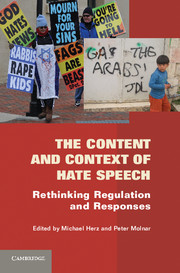Book contents
- Frontmatter
- Contents
- Contributors
- Foreword: Hate Speech and the Coming Death of the International Standard before It Was Born (Complaints of a Watchdog)
- Foreword: Hate Speech and Common Sense
- Acknowledgments
- Introduction
- Part I Overviews
- Part II Refinements and Distinctions
- Part III Equality and Fear
- Part IV International Law
- 22 Does International Law Provide for Consistent Rules on Hate Speech?
- 23 State-Sanctioned Incitement to Genocide
- 24 A Survey and Critical Analysis of Council of Europe Strategies for Countering “Hate Speech”
- 25 The American Convention on Human Rights
- 26 Orbiting Hate? Satellite Transponders and Free Expression
- Index
- References
25 - The American Convention on Human Rights
Regulation of Hate Speech and Similar Expression
Published online by Cambridge University Press: 05 June 2012
- Frontmatter
- Contents
- Contributors
- Foreword: Hate Speech and the Coming Death of the International Standard before It Was Born (Complaints of a Watchdog)
- Foreword: Hate Speech and Common Sense
- Acknowledgments
- Introduction
- Part I Overviews
- Part II Refinements and Distinctions
- Part III Equality and Fear
- Part IV International Law
- 22 Does International Law Provide for Consistent Rules on Hate Speech?
- 23 State-Sanctioned Incitement to Genocide
- 24 A Survey and Critical Analysis of Council of Europe Strategies for Countering “Hate Speech”
- 25 The American Convention on Human Rights
- 26 Orbiting Hate? Satellite Transponders and Free Expression
- Index
- References
Summary
Hate speech is defined by both its intent and its target. With respect to intent, hate speech is speech designed to intimidate, oppress, or incite hatred or violence on the basis of characteristics such as race, religion, nationality, gender, sexual orientation, or disability. With respect to its target, it is speech directed against a person or group based on such characteristics. Historically, hate speech has known no boundaries of time or place. It has been used by officials and others in Nazi Germany, by the Ku Klux Klan in the United States, by a full range of actors in Bosnia during the 1990s, and during the 1994 Rwandan genocide. But hate speech has a common thread: It is used to harass, to persecute, and to justify the deprivation of human rights. At its most extreme, hate speech can be used even to rationalize murder, as the world saw just a few years ago in Rwanda.
In the wake of the German Holocaust, and with the rise of the Internet and other media that can spread hate speech almost instantaneously, many governments and intergovernmental bodies have tried to limit the harmful effects of hate speech. Around the world, countries have criminalized incitement to hatred or violence; degrading, defamatory, or insulting speech; the display of discriminatory symbols or emblems; the possession and distribution of discriminatory materials; and the approval or justification of genocide or crimes against humanity. Some of these criminal prohibitions also reach new forms of hate speech, such as genocide denial or minimization and religious defamation.
- Type
- Chapter
- Information
- The Content and Context of Hate SpeechRethinking Regulation and Responses, pp. 499 - 513Publisher: Cambridge University PressPrint publication year: 2012
References
- 2
- Cited by



